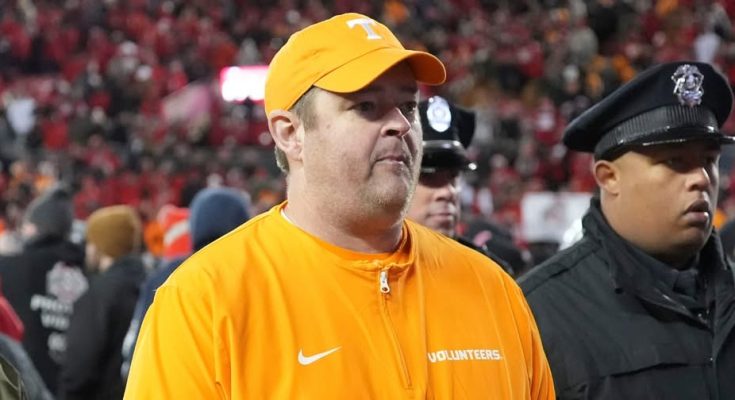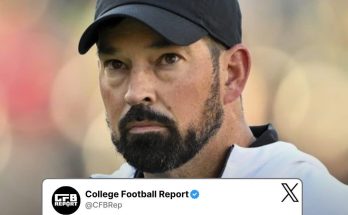Josh Heupel’s tenure as the head coach of the Tennessee Volunteers has been one marked by ambition, excitement, and a full-speed-ahead offensive identity that electrified the SEC and brought the Vols back into the national spotlight. But last season’s College Football Playoff loss to the Ohio State Buckeyes presented a sobering reality that even the most dynamic offensive systems and inspired locker room cultures still have to pass through the crucible of elite competition and postseason pressure. As the sting of that defeat began to fade, what lingered longer for Heupel was not the scoreboard, but the valuable, painful lessons etched into every drive, every call, and every inch of turf contested in that high-stakes showdown. In his post-season interviews and media appearances, Heupel was candid about the experience, offering rare and valuable insight into what that game revealed—not just about his team, but about his program’s growth and what’s required to compete consistently at the top level of college football.
From the opening kickoff against the Buckeyes, it was clear that the intensity of a playoff atmosphere was something entirely different from the regular season, even in the rugged world of the SEC. Tennessee had surged into the playoffs behind a high-octane offense, a confident quarterback room, and a defensive unit that, while inconsistent, had shown flashes of resiliency when it mattered most. But facing Ohio State on the biggest stage highlighted a discrepancy in areas Tennessee had yet to fully master—particularly in physicality at the line of scrimmage, situational discipline, and depth. Heupel did not deflect responsibility. Instead, he embraced the opportunity to evaluate how the Vols measured up against one of the sport’s true blue bloods.
Heupel’s biggest takeaway from the playoff loss centered around the notion of sustainable success being built not just on talent and scheme, but on mental toughness and relentless execution. “The moment was not too big for our guys,” he said in one of his post-game reflections. “But in moments like that, every missed assignment, every lack of eye discipline, every hesitation—those get magnified. And we saw that up close.”
It wasn’t just about the final score; it was about how Tennessee responded when the tempo slowed and Ohio State imposed its will physically. One of the biggest revelations for Heupel was how his team struggled to match the Buckeyes’ physicality on both lines. While Tennessee’s offensive line had held up well against SEC competition, the Buckeyes’ defensive front presented an entirely different level of athleticism and technical precision. Plays that usually developed in rhythm were suddenly disrupted. The Vols’ run game, often efficient and explosive, was clogged up before it could develop. The passing lanes that had opened regularly in SEC play were tighter, contested, and often forced quicker decisions. For Heupel, it wasn’t just about play calling—it was about how every player from the line to the perimeter responded when a top-five caliber opponent brought pressure from every angle.
In the weeks following the game, Heupel and his coaching staff conducted a deep film study, not just on the Ohio State loss, but on the season as a whole. They didn’t just chart plays—they charted reactions. They focused on the seconds between the snap and decision-making, the body language after missed tackles, and how leadership surfaced—or didn’t—during adversity. What Heupel concluded was that while Tennessee had indeed turned a corner in terms of national competitiveness, they were still in the process of learning how to finish in those moments. The Ohio State game became a teaching tool, a real-world case study in what it looks like when every inch matters, and the smallest mistakes can be the difference between extending a drive or giving up momentum.
Perhaps one of the most sobering lessons came in special teams. Heupel has often emphasized the hidden yardage battle, and against Ohio State, the Vols lost it—badly. Starting field position was noticeably skewed, as Tennessee’s return game failed to give the offense advantageous positioning, while Ohio State routinely capitalized on short fields. Heupel later remarked that while special teams often get less attention than offense or defense, the playoff game reiterated just how essential they are when competing at the national level. A 7-yard difference on average starting field position may not sound like much, but when every possession matters and defenses are elite, that differential becomes a major hurdle.
Another area Heupel acknowledged was the need for greater defensive versatility. While the Vols’ defense had shown marked improvement throughout the regular season, the Buckeyes’ ability to adapt mid-game exposed Tennessee’s lack of depth and schematic flexibility. Ohio State adjusted their protections and started isolating matchups that Tennessee’s secondary couldn’t consistently handle. When the Vols attempted to bring more pressure, the Buckeyes responded with quick releases and counters. When they sat back in coverage, Ohio State controlled the clock and tempo. Heupel’s takeaway? “You don’t just need a Plan B. You need a Plan C, D, and E—especially against a team with that kind of offensive versatility.”
One of the most teachable moments for Heupel and his team came in the third quarter, during a sequence that perfectly encapsulated the margins of playoff football. After forcing a three-and-out, Tennessee had a chance to shift momentum with a deep drive. On 2nd and short near midfield, a miscommunication on the snap count led to a false start, backing them up and disrupting rhythm. The next play, under pressure, the quarterback forced a throw into tight coverage that was tipped and intercepted. In regular season play, mistakes like that might be recoverable. In the playoffs, they’re often fatal. Heupel later recounted that moment as a turning point—not just in the game, but in how he would emphasize poise, communication, and clock awareness during offseason training.
Leadership also became a major focus in Heupel’s post-game reflection. While Tennessee had undeniable talent, Heupel noticed that in the most critical junctures of the game, there were missed opportunities for veteran players to steady the ship. He spoke openly about the need to cultivate not just athletic skill, but what he called “situational leadership”—players who know when to speak up, who can hold teammates accountable mid-series, and who understand the emotional flow of high-stakes games. “You win championships with leaders in the huddle, not just talent on the field,” he explained. That realization influenced Tennessee’s offseason leadership council meetings, where seniors and upperclassmen were invited to share insights and help create internal accountability structures.
Heupel also used the loss as a benchmark for recruiting. One of the most direct lessons from the Ohio State game was how elite depth translates into resilience. Where Tennessee rotated 5-6 linemen across the game, the Buckeyes seemed to reload seamlessly, keeping fresh legs on the field and wearing down Tennessee’s defensive front. From that point forward, Heupel doubled down on recruiting battles in the trenches—not just for 5-star starters, but for high-ceiling backups who could develop into contributors. “Games like that teach you that it’s not just about your best 22—it’s about your best 40,” he told local media.
Even in defeat, Heupel found seeds of optimism. Tennessee didn’t fold. They responded with pride, kept battling, and showed that the foundation he was building had real substance. There were players who elevated their play under pressure, young athletes who showed they belonged on that stage, and assistant coaches who made valuable in-game adjustments. These glimmers of competitiveness in a high-pressure environment reassured Heupel that Tennessee wasn’t out of place—they were just not quite ready to take the final step.
In the months following the loss, the Volunteers’ spring and summer practices took on a different tone. There was an urgency to correct details, to master the fundamentals, and to install pressure simulations during drills. Heupel even brought in guest speakers—including former NFL and college champions—to speak about what it takes to win at the highest levels. The message was consistent: talent opens the door, but execution, discipline, and culture keep it open.
Perhaps most impactful, though, was Heupel’s own self-reflection as a coach. He acknowledged that there were moments in the game where he could have adjusted faster, trusted different personnel, or approached clock management differently. That humility became a powerful motivator—not only for the staff but for the players who saw their coach taking responsibility and using the loss as fuel for growth. Heupel has long preached a “next-play” mentality, and in the aftermath of the playoff disappointment, he embodied that philosophy fully.
Heading into the new season, Tennessee looks different. The roster is deeper. The players more experienced. The staff more cohesive. But perhaps the most important difference is intangible: a sharpened edge born from a single game that taught them more than a dozen wins ever could. Heupel’s biggest takeaway was clear—being good is not enough. Being elite requires preparation that transcends the ordinary. It requires mastering moments when the stakes are highest and the margin for error is razor-thin. It requires resilience when momentum shifts, clarity in chaos, and a belief system that holds steady under pressure.
As Tennessee prepares for another run at the SEC crown and beyond, that playoff loss to Ohio State isn’t just a memory—it’s a blueprint. One that Josh Heupel and his staff have studied, internalized, and used as the foundation for the next chapter of Vols football. In the unforgiving world of college football, the greatest lessons often come through failure. For Heupel, that loss wasn’t the end of a season—it was the beginning of something far more important: the transformation from contender to true champion.



